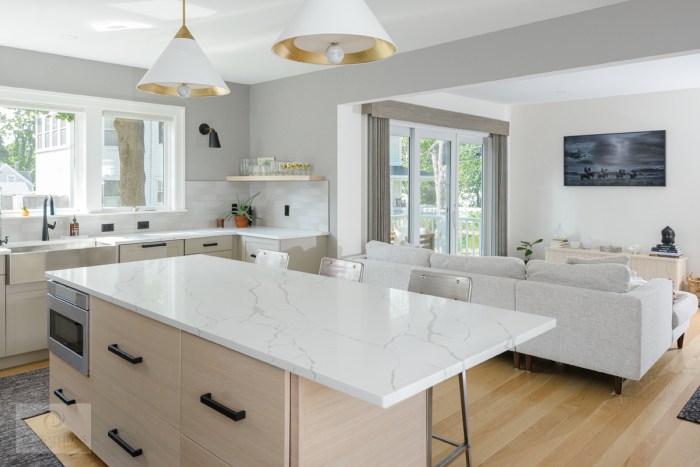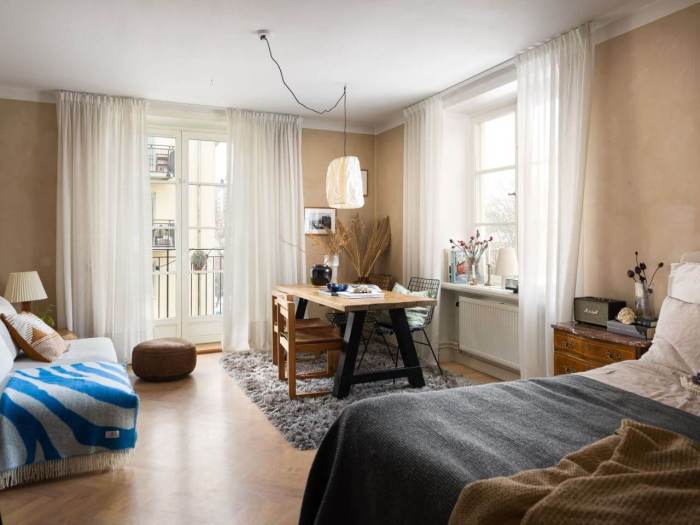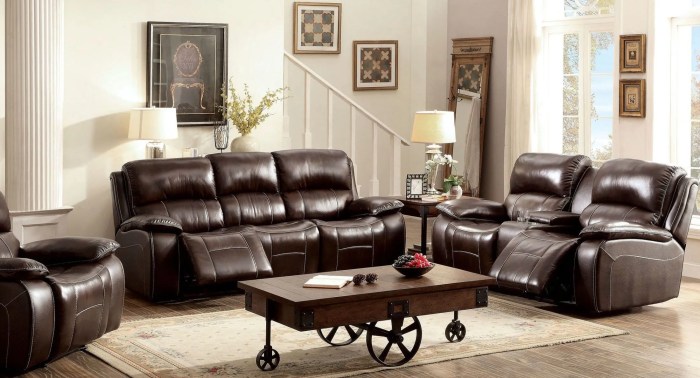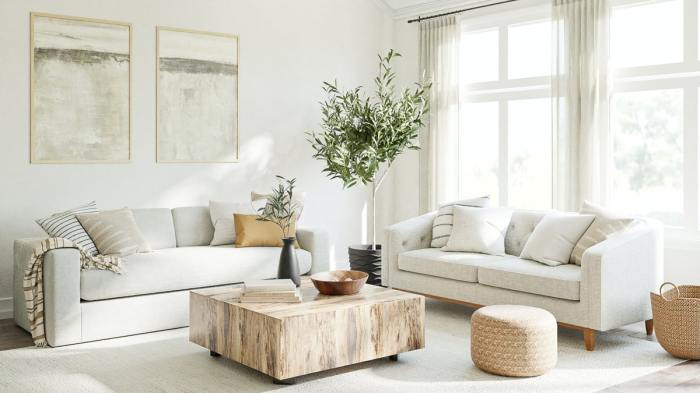Raumgestaltung
Wohnzimmer und küche in einem raum – Yo, check it! Open-plan living and kitchens are totally trending right now. It’s all about that seamless flow, connecting your chill zone with your cooking space. But designing it right? That’s where the real skill comes in. Let’s break down some ways to make your open-plan kitchen/living room – pop*.
Gestaltungsmöglichkeiten für offene Wohnküchen
So, you’ve got this awesome space, a blank canvas. The possibilities are endless, dude! You can go full-on modern minimalist, rustic farmhouse chic, or even a crazy eclectic mix. Think about how you want to use the space – big family dinners? Chill movie nights? Epic gaming sessions?
Your lifestyle should totally dictate the design. Consider the natural light, the flow of traffic, and how you want to define the different zones within the room. Maybe a bar counter to separate the kitchen from the living area? Or a rug to define the living room space? Get creative!
Vor- und Nachteile offener Wohnküchen
| Vorteil | Nachteil | Vorteil | Nachteil |
|---|---|---|---|
| Mehr Licht und Raumgefühl | Gerüche verbreiten sich schneller | Perfekt für gesellige Abende | Lärm aus der Küche kann störend sein |
| Flexibilität bei der Einrichtung | Weniger Privatsphäre beim Kochen | Ideal für Familien mit Kindern (Aufsicht) | Unordnung ist schneller sichtbar |
| Erhöhter Immobilienwert | Höhere Ansprüche an Sauberkeit | Modernes und stylisches Design | Mehr Aufwand bei der Reinigung |
Einrichtungsstile für offene Wohnküchen
Here’s the deal: three totally different vibes for your open-plan kitchen/living room. Pick the one that best reflects your personality – or mix and match elements to create something unique.
Moderner Einrichtungsstil
Think sleek lines, minimalist aesthetics, and a neutral color palette. Imagine a high-gloss white kitchen with stainless steel appliances, paired with a comfy grey sofa and a glass coffee table. Subtle pops of color, like teal or mustard yellow, add personality without overwhelming the space. Think clean lines, lots of natural light, and maybe some cool geometric patterned rugs to add some texture.
Minimalist doesn’t mean boring – it’s all about carefully chosen, high-quality pieces.
Rustikaler Einrichtungsstil
This style is all about warmth and coziness. Imagine exposed brick walls, wooden beams, and a farmhouse-style kitchen with a large island. Think natural materials like wood, stone, and linen. A comfy armchair, a fireplace, and lots of plants create a relaxed and inviting atmosphere. The colors are warm and earthy – think browns, creams, and greens.
Maybe a vintage rug to add some character. This style is super chill and perfect for those who value comfort and a relaxed vibe.
Minimalistischer Einrichtungsstil
Less is definitely more here. A minimalist open-plan kitchen/living room is all about clean lines, neutral colors, and a focus on functionality. Think a simple white kitchen with integrated appliances, paired with a sleek sofa and a few carefully chosen accessories. The space is uncluttered and calming, with a focus on natural light and a sense of spaciousness.
Think light wood, white walls, and maybe one statement piece of art to add a touch of personality. This style is perfect for those who appreciate simplicity and order.
Küchenplanung in offener Raumgestaltung: Wohnzimmer Und Küche In Einem Raum

Source: transitionskbr.com
Yo, check it! Open-plan living is totally in right now, but merging your kitchen and living room needs some serious strategizing. Think of it like this: you’re building a dope custom car – you gotta make sure all the parts work together seamlessly, right? Same goes for your kitchen and living space. We’re gonna break down how to plan your kitchen layout for maximum style and functionality in your open-concept space.
The key to a killer open-plan kitchen is nailing the workflow. We’re talking about the “Arbeitsdreieck” – that’s German for “work triangle,” and it’s the holy grail of kitchen design. This triangle connects your three main kitchen zones: the fridge, the sink, and the stove. The goal is to keep these points close together but not cramped, creating a smooth and efficient cooking flow.
Think of it like a well-oiled machine – everything moves smoothly and effortlessly.
Optimale Anordnung von Küche und Wohnzimmer
A smart kitchen layout in an open-plan space maximizes both functionality and visual appeal. Imagine a sleek, modern kitchen island acting as a natural divider between the kitchen and living area. This island can serve as a breakfast bar, extra counter space, and even incorporate a sink or cooktop. Alternatively, a peninsula design—a counter that extends from one wall—can create a similar separation while maintaining an open feel.
The placement of the island or peninsula should consider the flow of traffic between the living room and kitchen to avoid bottlenecks. For example, in a larger space, a centrally located island works well, while in a smaller space, a peninsula against a wall might be a better choice. Consider the natural light sources in your space as well – you want to make sure the kitchen is well-lit and inviting.
Skizze einer offenen Küche
Let’s visualize a rad open kitchen design. Picture this: a linear kitchen design along one wall, maximizing space and creating a clean, modern look. The counter tops are sleek quartz, maybe a light grey or even a bold dark blue. The cabinetry is minimalist and white, offering plenty of storage. Integrated appliances blend seamlessly into the design, maintaining a streamlined aesthetic.
A stylish backsplash, perhaps a geometric tile pattern, adds a pop of personality. Opposite the linear kitchen, a large, central island with a butcher block countertop provides ample prep space and a casual dining area. The island’s overhang creates a natural separation between the kitchen and living areas, while still allowing for an open and airy feel.
Imagine soft, ambient lighting underneath the island counter, creating a cozy atmosphere in the evenings. This design maximizes space and creates a flow that’s both functional and aesthetically pleasing.
Raumtrennung in offener Gestaltung
Defining zones in an open-plan space is key to avoiding that chaotic vibe. Here are a few stylish ways to subtly separate the kitchen from the living area without building walls: Think about using different flooring materials – perhaps hardwood in the living area and tile in the kitchen. Rugs can also help define spaces and add warmth and texture.
Strategic lighting is another powerful tool – pendant lights over the kitchen island create a focal point and visually separate the areas. A change in ceiling height can also create a subtle but effective division. Even something as simple as a change in wall color can help define zones. For instance, a warmer, more inviting tone in the living area, contrasted by a cooler, more functional tone in the kitchen.
Finally, shelving units or room dividers can add visual separation without feeling too closed off. Remember, the goal is to create distinct zones while maintaining the open and airy feel of the space.
Beleuchtung und Einrichtung
Yo, check it! Open-plan living and kitchens are all the rage, right? But getting the lighting and furniture right is key to making it feel chill and not like a chaotic mess. We’re talking about creating zones, setting the mood, and making this space totally – you*.Licht und Schatten schaffen eine coole Atmosphäre und definieren verschiedene Bereiche. Think about it: a bright, airy kitchen area for prepping your next epic meal, and a softer, more relaxed living area for chilling with your crew or binge-watching Netflix.
Lighting is your secret weapon to making this happen seamlessly.
Beleuchtungskonzept für offene Wohnküchen
A killer lighting plan needs layers. We’re talking ambient, task, and accent lighting – it’s the holy trinity of good lighting design. Ambient lighting sets the overall mood; think recessed lights in the ceiling for a general glow. Task lighting is super practical – under-cabinet lighting in the kitchen, for example, so you can actuallysee* what you’re doing while chopping veggies.
Finally, accent lighting highlights specific features or artworks – maybe some cool spotlights on a gallery wall or some fairy lights strung across a bookshelf. The right mix makes the space feel both functional and stylish.
Optische Trennung von Bereichen durch Licht und Schatten
This is where it gets fun. You can use lighting to create visual boundaries without building actual walls. For example, brighter lighting in the kitchen area will naturally draw the eye, making it feel distinct from the living area, which could have dimmer, warmer lighting. Strategic placement of lamps or pendant lights can also help define zones.
Think about using a bold pendant light over your kitchen island as a focal point, separating it from the surrounding living space. Shadows play a big role too – a strategically placed floor lamp can cast a cozy shadow, creating a sense of intimacy in the living area.
Empfehlungen für Möbel und Dekoration
Yo, furniture is where you really express your style. Keep it consistent with the overall vibe you’re going for. A modern kitchen might rock sleek, minimalist furniture, while a bohemian space might feature comfy, eclectic pieces. Think about flow and functionality – choose furniture that doesn’t block pathways or make the space feel cramped. Mixing textures and materials – like wood, metal, and fabric – adds visual interest and depth.
Don’t forget about plants! They bring life and freshness to any space, plus they’re totally Instagrammable. Accessorize with cushions, throws, and artwork that reflect your personality – this is your space, make it pop!
Materialien und Farben
Yo, check it! Designing your open-plan living room and kitchen? Material choices and color schemes are where the magic happens. Getting this right totally sets the vibe and makes your space feel, like,amazing*. We’re talking about creating a chill zone that’s both stylish and functional – think comfy hangouts and effortless cooking sessions.Die Auswahl der richtigen Materialien und Farben ist entscheidend für die Atmosphäre und Funktionalität eines offenen Wohn-Küchen-Bereichs.
Es geht darum, einen Raum zu schaffen, der sowohl gemütlich als auch stilvoll ist und gleichzeitig den Bedürfnissen des täglichen Lebens gerecht wird. Die richtige Kombination kann einen kleinen Raum größer wirken lassen oder einen großen Raum gemütlicher gestalten.
Bodenbeläge
Für den Boden einer offenen Wohnküche eignen sich verschiedene Materialien. Natürliche Materialien wie Holz (z.B. Parkett oder Landhausdielen) schaffen eine warme und gemütliche Atmosphäre. Sie sind jedoch etwas empfindlicher gegenüber Kratzern und Feuchtigkeit. Fliesen, insbesondere großformatige Fliesen, wirken modern und pflegeleicht, sind aber im Winter möglicherweise etwas kalt unter den Füßen.
Ein Vinylboden bietet eine gute Alternative, da er strapazierfähig, wasserfest und in verschiedenen Designs erhältlich ist. Teppiche können in bestimmten Bereichen, z.B. im Wohnbereich, für mehr Gemütlichkeit sorgen, sollten aber in der Nähe des Kochbereichs vermieden werden, um Flecken zu vermeiden. Die Wahl des Materials hängt letztendlich von den persönlichen Vorlieben und dem Budget ab.
Wandgestaltung
Die Wandgestaltung beeinflusst die Atmosphäre des Raumes maßgeblich. Helle Farben wie Weiß oder Cremefarben lassen den Raum größer wirken. Akzentwände in kräftigeren Farben setzen optische Highlights und können den Raum strukturieren. Tapete kann Textur und Muster hinzufügen, während Putz eine rustikale oder moderne Optik verleiht. In der Küche können Fliesen als Spritzschutz eine praktische und stilvolle Lösung sein.
Auch hier gilt: Die Wahl hängt vom persönlichen Geschmack und dem Gesamtstil des Raumes ab. Stell dir vor: eine Wand mit coolen Retro-Tapeten, die den ganzen Raum aufpeppt!
Wohnzimmer und Küche in einem Raum? Geht super, vor allem wenn man den Raum clever einteilt. Ein skandinavischer Stil, wie man ihn auf wohnzimmer skandinavischer stil sieht, bietet sich da besonders an: helle Farben, viel Holz und natürliche Materialien schaffen eine luftige Atmosphäre, die auch in einer offenen Wohnküche toll wirkt. So bleibt der Raum trotz der Kombination aus Wohn- und Kochbereich hell und einladend.
Küchenarbeitsplatten
Die Arbeitsplatte ist das Herzstück der Küche. Granit ist ein Klassiker – robust, hitzebeständig und sieht edel aus. Marmor ist ebenfalls sehr beliebt, aber empfindlicher gegenüber Flecken. Laminat ist eine preisgünstigere Alternative, die in verschiedenen Farben und Mustern erhältlich ist. Holz bietet eine warme und natürliche Optik, benötigt aber regelmäßige Pflege.
Auch hier ist die Wahl eine Frage des Geschmacks, des Budgets und der gewünschten Pflegeintensität. Denk an die tägliche Nutzung und wähle ein Material, das diesem Stand hält!
Farbpalette für eine gemütliche Atmosphäre
Eine harmonische Farbpalette ist wichtig für eine entspannte Atmosphäre. Neutrale Töne wie Beige, Grau und Weiß bilden eine perfekte Basis. Diese lassen sich mit Akzentfarben wie einem satten Grün, einem warmen Braun oder einem sanften Blau kombinieren. Ein Beispiel: Eine Kombination aus hellem Grau für die Wände, einem warmen Beige für den Boden und Akzenten in einem tiefen Olivgrün an den Küchenmöbeln und Accessoires.
Denk daran: Zu viele kräftige Farben können schnell überfordern. Weniger ist oft mehr!
Optische Raumgestaltung mit Materialien und Farben
Helle Farben und glänzende Oberflächen lassen Räume größer wirken. Dunkle Farben und matte Oberflächen können Räume gemütlicher, aber auch kleiner erscheinen. Spiegel können ebenfalls dazu beitragen, einen Raum optisch zu vergrößern. Die Wahl der Materialien und Farben sollte daher strategisch erfolgen, um den Raum bestmöglich zu gestalten. Ein Beispiel: Ein kleiner Raum wirkt größer, wenn helle Farben an den Wänden und hellen Bodenbelägen verwendet werden.
Große Räume können mit dunklen Farben und strukturierten Materialien gemütlicher gestaltet werden.
Gerüche und Lärm

Source: thenordroom.com
Yo, check it! Open-plan living and kitchens are totally trendy, but let’s be real, smells and noise can totally crash the vibe. This section breaks down how to keep your chill zone chill, even with a kitchen in the mix. We’re talking serious strategies to keep things fresh and quiet.Geruchsreduzierung in der offenen Wohnküche ist mega wichtig für ein entspanntes Wohngefühl.
Nobody wants their living room smelling like last night’s garlic bread, right? We’re diving into practical solutions to keep those kitchen odors contained.
Maßnahmen zur Geruchsreduzierung
Ein leistungsstarker Dunstabzug ist dein bester Freund. Think of it as the bouncer at a club, keeping the bad smells out of the main space. Choose a model with a high extraction rate and multiple speed settings for maximum flexibility. Proper ventilation is also key – make sure your kitchen has adequate exhaust fans and windows that can be opened for natural airflow.
Regular cleaning of the hood filter is also crucial. A neglected filter will reduce the effectiveness of your extractor fan. Consider adding air purifiers with activated carbon filters, especially if you’re dealing with particularly stubborn smells. These filters are specifically designed to absorb odors. Think of them as your backup plan against lingering smells.
Mögliche Lärmquellen und Lärmminderung, Wohnzimmer und küche in einem raum
Okay, so the kitchen can get noisy. The dishwasher, the blender, the garbage disposal – they all contribute to the overall sound level. Let’s strategize ways to make it less of a racket. Proper kitchen planning is essential. Positioning noise-producing appliances away from the living area is a simple yet effective solution.
Consider using sound-absorbing materials in the kitchen area, like acoustic panels or rugs, to dampen sound reflections. Investing in quieter appliances can make a huge difference. Look for models with lower decibel ratings. And finally, strategic placement of furniture can help to create sound barriers. A large sofa or bookshelf positioned strategically can help absorb some of the noise.
Integration von Dunstabzugshaube und geräuscharmen Geräten
Yo, this is where design meets function. The location of your range hood is crucial. Install it directly above the stovetop to maximize its effectiveness. Consider a downdraft ventilation system that retracts into the countertop when not in use, saving space and keeping a sleek look. Choosing quieter appliances, like a dishwasher with a low decibel rating, is a must.
And don’t forget about the sound-absorbing materials mentioned earlier; strategically placed rugs and acoustic panels can make a noticeable difference in the overall sound level of the open-plan space. A well-designed kitchen with careful appliance selection and placement can make a huge difference in creating a calm and relaxing atmosphere.
Stauraum und Organisation
Yo, check it! Open-plan living and kitchens are super trendy, but keeping things organized can be a total vibe killer. Think of it like this: your space is your canvas, and clutter is graffiti that nobody wants. Smart storage is the key to keeping your chill zone chill.Clever storage solutions are crucial in an open-plan kitchen-living area.
You need to maximize space and maintain a seamless flow between the two zones. We’re talking about maximizing every nook and cranny, creating a space that’s both stylish and functional – think Marie Kondo meets minimalist modern.
Optimale Stauraumlösungen
Different storage solutions cater to different needs. High cabinets offer vertical storage for less frequently used items like seasonal dishes or extra linens. Think sleek, floor-to-ceiling units that blend seamlessly with the wall. Rolling carts provide mobile storage, perfect for frequently used items like spices or cooking utensils. Imagine a stylish, chrome cart easily wheeled to the stovetop during dinner prep, then tucked away in a corner when not in use.
Built-in drawers within countertops provide hidden storage for cutlery, utensils, and other essentials, maintaining a clean, uncluttered look. Picture sleek, wooden drawers that blend perfectly with the countertop, almost invisible until you need them.
Optimale Stauraumnutzung in Küche und Wohnbereich
Think of your entire space as one unit, not two separate areas. In the kitchen, utilize every inch – drawers, shelves, cabinets, even the space above cabinets. In the living area, consider using storage ottomans, coffee tables with drawers, or built-in shelving units to store books, blankets, and other living room items. This creates a unified aesthetic and prevents the kitchen from becoming an overflowing storage area.
A stylish, large ottoman with hidden storage could double as extra seating and a discreet storage solution for throw blankets and remotes.
Tipps zur Organisation und Aufräumung
Maintaining an organized open-plan kitchen-living area requires consistent effort, but the results are totally worth it. Here are some tips to stay on top of things:
- Declutter regularly: Get rid of items you don’t need or use. A regular purge keeps things from getting out of control.
- Utilize vertical space: Maximize shelving and wall-mounted storage to keep countertops clear.
- Label everything: Clear labels make it easy to find what you need and maintain order.
- Invest in matching containers: Uniform containers create a clean, cohesive look and help with organization.
- Designate a cleaning zone: Keep cleaning supplies tucked away but easily accessible in a designated area to keep cleaning simple and efficient.
Remember, a clean and organized space is a happy space. Keep it fresh, keep it clean, and keep it stylish.
Beispiele und Inspirationen
Yo, check it! Open-plan living and kitchens are totally trending, right? But making it work? That’s where the real skill comes in. Here are three different vibes to inspire your own killer kitchen-living room combo. We’re breaking down the good, the bad, and the totally Instagrammable.
Drei Beispiele Offener Wohnküchen
Okay, so picture this: First up, we’ve got a super modern space. Imagine sleek, white cabinetry that stretches from floor to ceiling, creating a clean, minimalist look. The countertops are a dark grey quartz, offering a sophisticated contrast. A large, central island, also in white, acts as both a prep area and a casual dining spot. Above the island, three industrial-style pendant lights hang down, casting a warm glow.
The living area features a plush grey sofa, a minimalist coffee table, and a large, floor-to-ceiling window that lets in tons of natural light. The whole space feels bright, airy, and incredibly stylish. The second example is a more rustic-chic design. Think exposed wooden beams on the ceiling, warm-toned wooden cabinets, and a stone backsplash. The kitchen island is made of reclaimed wood, adding a touch of vintage charm.
A large farmhouse sink sits proudly under a window overlooking a garden. The living area features a comfy, oversized sofa with lots of throw pillows, a chunky knit throw blanket, and a fireplace. It’s cozy, inviting, and feels incredibly homey. Lastly, we have a bohemian-inspired space. This one is all about vibrant colors, eclectic patterns, and a relaxed vibe.
The kitchen features colorful cabinets, open shelving, and a mix of materials like wood, metal, and tile. The island is a bold, jewel-toned color, and the backsplash is a stunning mosaic tile. The living area is filled with comfy seating, colorful rugs, and lots of plants. The whole space feels lively, creative, and totally unique.
Vergleich der Beispiele: Vor- und Nachteile
Let’s break down the pros and cons. The modern design is super sleek and easy to clean, but it can feel a bit cold and impersonal to some. The rustic-chic design is warm and inviting, but it might require more maintenance. The bohemian space is fun and expressive, but it can feel cluttered if not carefully curated. It’s all about finding the style that best suits your personality and lifestyle.
Analyse der Gestaltungselemente und Gestaltungsprinzipien
So, what makes these spaces work? Well, the modern space uses the principle of minimalism, creating a sense of calm and order. The rustic-chic space utilizes natural materials and textures to create a cozy and inviting atmosphere. The bohemian space embraces eclecticism and layers different textures and colors to create a visually stimulating environment. All three examples use lighting effectively to highlight key features and create different moods.
They also demonstrate the importance of balancing form and function – a stylish space needs to be practical too. It’s about finding that sweet spot between aesthetics and functionality. Think about your own style and how you want your space to feel. That’s the key to creating an awesome open-plan living and kitchen.
Welche Bodenbeläge eignen sich am besten für eine offene Wohnküche?
Strapazierfähige und pflegeleichte Materialien wie Fliesen, Laminat oder Vinyl sind für den Küchenbereich empfehlenswert. Im Wohnbereich kann je nach Stil Holz oder Teppich gewählt werden. Ein durchgängiger Bodenbelag sorgt für ein einheitliches Raumgefühl.
Wie kann man die Gerüche beim Kochen effektiv reduzieren?
Eine leistungsstarke Dunstabzugshaube ist essentiell. Zusätzlich können Kochmethoden wie Dünsten oder Backen im Vergleich zu Braten die Geruchsbildung minimieren. Regelmäßiges Lüften ist ebenfalls wichtig.
Welche Möglichkeiten gibt es zur optischen Trennung von Wohn- und Küchenbereich?
Unterschiedliche Bodenbeläge, unterschiedliche Wandfarben oder -strukturen, eine Kücheninsel als Raumteiler oder ein freistehendes Regal können den Raum optisch gliedern.
Wie wichtig ist die Beleuchtung in einer offenen Wohnküche?
Eine mehrstufige Beleuchtung mit Arbeitsbeleuchtung über der Küchenzeile, Ambientebeleuchtung im Wohnbereich und allgemeiner Raumbeleuchtung schafft eine angenehme Atmosphäre und betont die verschiedenen Zonen.



